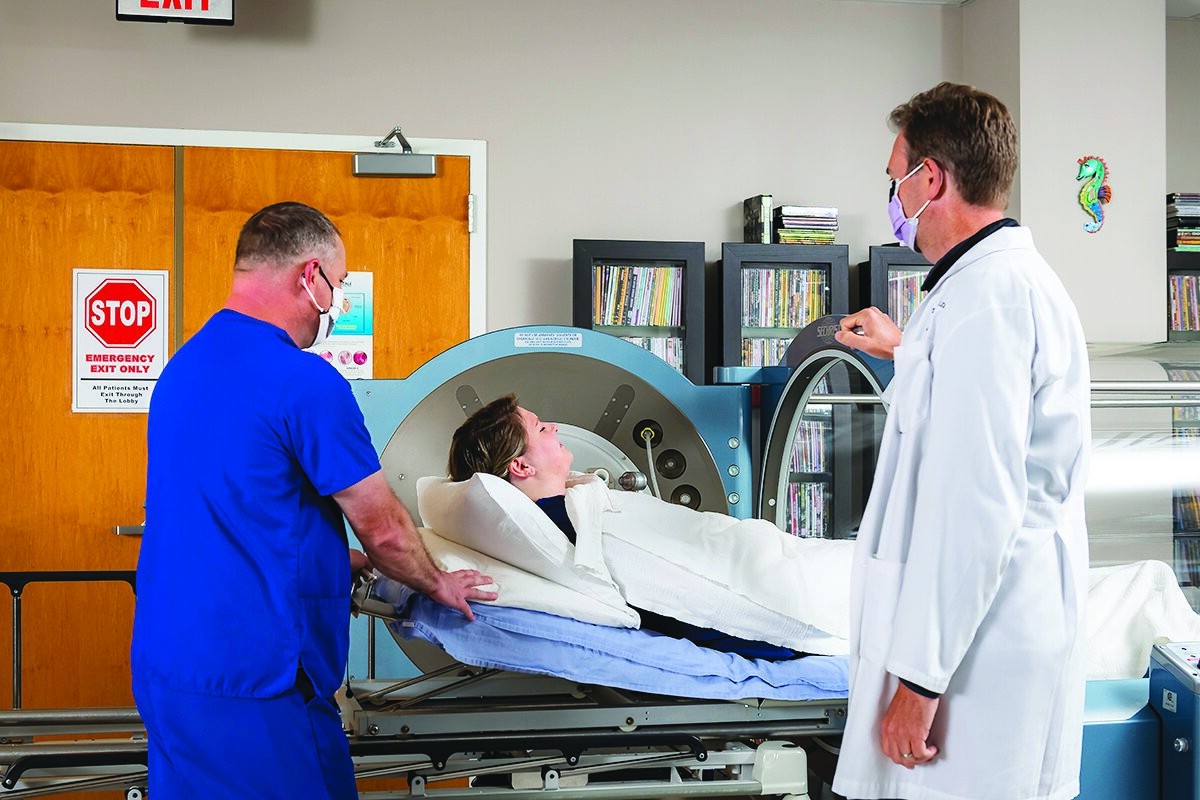After finishing radiation therapy for prostate cancer, some men may begin to experience urinary bleeding, pelvic pain, or feel like they need to use the bathroom more frequently. These are symptoms of a delayed radiation injury, and around 5% of patients who receive pelvic radiation will experience this delayed side effect months and sometimes years after radiation treatment.
An effective treatment option for soft tissue radionecrosis after prostate cancer is hyperbaric oxygen therapy (HBOT), which works by exposing the body to medical-grade oxygen to flood damaged, oxygen-starved tissues with extra oxygen and stimulate new blood vessel growth. This helps tissues injured by radiation to rebuild and recover.
Read on to learn how hyperbaric oxygen therapy promotes recovery, reduces radiation side effects, and where to find the best hyperbaric oxygen therapy clinic in Cumming.
What is Hyperbaric Oxygen Therapy?
Hyperbaric oxygen therapy takes place inside a pressurized chamber where patients struggling with the side effects of prostate cancer radiation breathe 99.7% medical-grade oxygen at a higher atmospheric pressure than normal room air.
This increased pressure saturates the bloodstream with oxygen, allowing it to reach tissues damaged by radiation therapy that have become hypoxic or inflamed. Over the course of multiple sessions, this oxygen boost can encourage the growth of new blood vessels, reduce inflammation, and support healing in areas that no longer receive sufficient oxygen on their own.
Many patients find the treatment experience calm and predictable, often listening to music or reading while the chamber gently pressurizes. By providing the body with the fuel it needs to repair itself, HBOT offers a non-invasive option for alleviating long-term side effects of external beam radiation therapy (EBRT) and other types of radiation used to treat prostate cancers.
The Benefits of HBOT for Cancer Recovery
Hyperbaric oxygen therapy for cancer recovery has gained growing attention among both patients and radiation oncologists for its proven ability to enhance tissue healing after cancer treatments. While it’s often recommended for those getting treatment for prostate cancers, especially when the prostate gland is exposed to radiation or removed through radical prostatectomy, HBOT may support healing in other parts of the body affected by cancer treatment as well.
HBOT is especially valuable for men who experience frequent urination, pelvic pain, or tissue damage after therapies like hormonal therapy or radiation aimed at the prostate.
In cases where cancer has spread beyond its original site, HBOT may be recommended alongside other treatments to support recovery and reduce symptoms caused by radiation’s impact on healthy tissue.
What to Expect When Getting HBOT Treatment After Prostate Radiation
Patients who have undergone external beam radiation therapy and other types of radiation therapy often describe their HBOT sessions as calm and quiet, where they rest in the chamber, sometimes reading or listening to music, as their body receives the oxygen it needs to accelerate healing. Most people receiving HBOT for radiation injury after prostate cancer treatment attend sessions on a few days a week, with each session lasting about 60 to 90 minutes inside a pressurized chamber.
The pressure, typically around two to two and a half times greater than normal air pressure, allows the lungs to take in significantly more oxygen than they can at sea level. A full course typically includes 30 to 40 sessions, although some patients may require more sessions depending on how their tissues respond.
During treatment, you lie comfortably inside a clear chamber, breathing 99.7% oxygen while trained technicians monitor your ears, sinuses, and blood pressure. Most people watch a movie, read, meditate, or nap.
Are There Any Risks of Getting HBOT?
Like any medical treatment, HBOT can have side effects, though most are mild and temporary. The most common issue is pressure in the ears, similar to what you might feel during an airplane descent, as the body adjusts to changes inside the chamber. Some people experience sinus pressure or feel tired.
These effects usually subside on their own once the sessions are complete. For most people, the experience feels uneventful. Choosing a facility accredited by the Undersea and Hyperbaric Medical Society (UHMS) makes a significant difference in safety. The FDA recommends only choosing a facility properly accredited by the UHMS.
Is HBOT Covered by Insurance or Medicare?
Most insurance plans, including Medicare, cover hyperbaric oxygen therapy when it is used to treat specific medical conditions that meet established criteria. Delayed radiation injury, also called soft-tissue radionecrosis, is one of those approved indications. Before treatment begins, our clinic can help confirm eligibility with your insurance, since coverage rules can vary slightly by region or insurer.
Discover the Best Hyperbaric Oxygen Therapy Clinic in Cumming for Radiation Injury After Prostate Cancer
At Regenerative and Hyperbaric Medicine, we combine proven science and physician-guided care to reduce your risk of side effects and provide your body with the oxygen it needs to repair, recover, and thrive.
Our UHMS-accredited facility has held this distinction since 2017 and maintains a perfect safety record, earning the trust of patients across Metro Atlanta, North Georgia, and the United States. Inside our state-of-the-art hyperbaric treatment centers, conveniently located in Cumming, Marietta, and Sandy Springs, you’ll find a dedicated team of Board-Certified experts and hyperbaric chambers designed for maximum oxygen delivery and comfort.
Ready to boost healing with the best hyperbaric oxygen therapy in Cumming, GA?

.svg)





